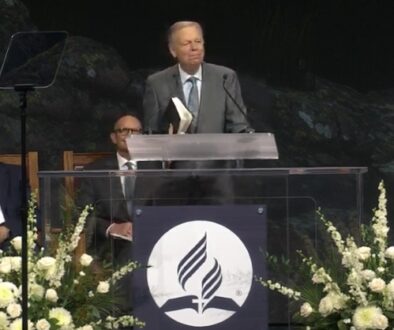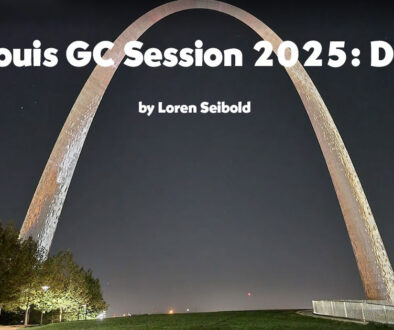Adventist General Conference Organized 150 Years Ago this Week
by Adventist Today News Team
This week in 1863, in the midst of the United States Civil War, a small group met in Battle Creek, Michigan, and formed the General Conference of Seventh-day Adventists, commonly called the GC by employees and members of the denomination. Six state conferences had organized over the previous three or four years and each sent delegates to the meeting.
The minutes of the meeting are only seven pages. The constitution and bylaws that the delegates developed during the meeting cover a little more than one page. The document specified a governing body of only three members called an "executive committee," the terminology still used in most denominational policy materials.
There were 10 delegates from Michigan, the state conference that hosted the session. Eight were ministers, including many of the most important personalities in the early Adventist movement. Two were lay representatives. New York sent four delegates, Ohio and Iowa sent two each and Minnesota and Wisconsin sent one each. Only 20 individuals made up that founding group.
Organization had been a hot issue. James White, the most prominent spokesman for the formation of a denomination, argued practically that he should not have to own the movement's publishing operation personally. It had been paid for with donations and should belong to all the members through some representative system.
Others felt that a formal organization was the first step toward worldliness, apostasy and all kinds of problems. The Amish and others insisted that no organization beyond local congregations that elected their own bishops were Biblical in any sense, and many in the first generation of Adventists took a similar view.
The state conferences had formed slowly. Initially they were simply an annual gathering and then committees were formed to oversee property such as large tents used for evangelism campaigns and local meetinghouses in a few locations. Most Adventist congregations met in homes.
Elder White had become a target because of his activist stance and one item of business in that first GC Session was the report of an investigation of White. The Battle Creek Church had voted at a special meeting on March 29 "to lay before the General Conference, in relation to the charges and reports that are in circulation concerning" White the fact that "no one had reported any grievances" and the 70 "fervent testimonials" in his support. The GC had not even been initiated and the politics had already started.
The delegates responded to the issue quite conservatively, allowing White to step aside although the majority evidently wanted him to serve as the first GC president. They also voted to publish an announcement in the Review opening up two months for people to file any comments they wished about White.
John Byington was elected the first GC president, a farmer from upstate New York and lay pastor who had been an activist in the anti-slavery movement, hiding fugitives on his property and helping them escape to Canada in defiance of Federal law. Adventists were involved in humanitarian work and took stands for human rights even before a denomination existed; it is part of the Adventist heritage.
Uriah Smith was voted GC secretary and E. W. Walker the GC treasurer, but neither of them were members of the executive committee. It included Byington, John N. Andrews and George W. Amadon. Andrews would become the denomination's first official missionary and one of the denomination's major universities is named after him.
"One object if the General Conference is to secure uniformity of action throughout all the states," the delegates voted, and then appointed a committee "to draw up a constitution for state conferences," despite the fact that at least the Ohio Conference already had one. Tension over "uniformity" instead of a more flexible and diverse unity began at the very first GC Session and continues to this day.
Historians estimate that in the 1860s there were only a few hundred Sabbath-keeping Adventists. They were scattered across the northern tier of the U.S. east and Midwest. There were none in the South, which was currently in rebellion against the Federal government and very likely only a handful in California, although within a few decades it would become home to the largest settlement of Adventists on the globe.
The Seventh-day Adventist denomination began as a very small, regional fellowship of mostly house-church groups in the United States, but it was soon to develop a world vision and a broad concept of mission. Within a few years it had started a hospital, a college, schools and city missions. It soon began to connect with believers in other nations and began sending missionaries, both officially sponsored and independent, self-supporting workers. The prophetic gift exercised by Ellen White, who was still in her 30s at the time of the GC founding session, constantly spurred innovation, expansion and a broad vision for the movement.
Today the Adventist movement is organized in almost all of the countries recognized by the United Nations, holds worship in more than 800 languages and has more than 30 million adherents. There are more Adventists on the globe than there are Jews or Sikhs or Baha'i, all venerable world religions. Yet the Adventist religion is less than 200 years old, a youngster in this class.
The news media has noted that the official recognition of this anniversary evidences ambivalence on the part of GC leaders. "There's not a whole lot of cheer to go around," stated the Religion News Service (RNS). "Not even for all the good they have accomplished through their faith across the world while they wait" for Jesus to return. The Christian Post noted "8,000 schools … more than 16 million medical outpatient visits" each year and "millions of dollars [in] charity" as it described the impact of the denomination today.
"I would love for [Jesus] to come this second," Janice Maitland, a member of Ephesus Church in Manhattan, was quoted by The Christian Post. "Once He returns there will be less suffering. We will be restored back to our perfect way, so that's always our desire. It always has been and always will be." She added, "I think it's presumptuous as human beings to tell God when He should return. … We can only hope that He will come as soon as He can but we can't tell Him when to come."
"Adventists are fundamentally caught between hope and reality," a retired theologian told Adventist Today. "That tension is at the very core of Adventist faith and it only gets more taut as more and more generations come and go." A growing number of Adventist families in North America, Europe and Australia have multiple generations of believers, "so it becomes a very personal tension in more and more families. It has been a creative tension for many people, while others seem unable to handle it in a creative, compassionate, Christ-like way. It sometimes results in very strange ideas and behavior."



